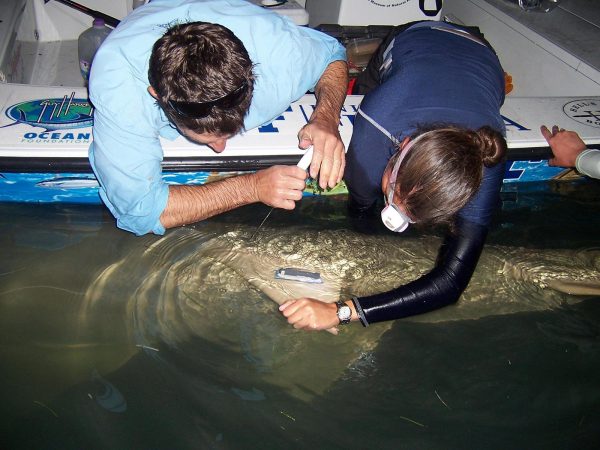Researchers at the Florida Museum recently received $24,000 from the Disney Worldwide Conservation Fund to continue studying the endangered smalltooth sawfish.

Florida Program for Shark Research photo
One of 75 grants distributed internationally by the Disney Conservation Fund, the award was the only one UF received this year. Researchers will use the funding to help maintain the International Sawfish Encounter Database, tag and track the movements of smalltooth sawfish, and promote conservation through an expanded website, public events and production of educational materials.
“We are delighted to receive this funding,” said George Burgess, director of the Florida Program for Shark Research at the Florida Museum. “We’re beginning to get some good information about the movement patterns and the habitat choices of these animals, and with this additional funding, we’re able to get more tags out – the more tags we get out there, the more refined we get in our understanding of what’s going on.”
Easily recognized by its long rostrum or “saw,” the species is an important part of Florida’s fauna. Its territory in the past ranged from New York to Texas and its decline has largely slipped past scientists in the last 100 years, Burgess said. Today, sawfish sightings are only reported in Florida.
“This critter is particularly threatened here in the United States,” he said. “Its sole remaining population is centered in southern Florida, so we as Floridians, above and beyond our national interest, have a very special obligation to save this animal.”
Records maintained in the International Sawfish Encounter Database help researchers understand changes in range and habitat. Museum researchers have used active tracking methods to record fine-movement patterns and will continue using passive tracking during fieldwork beginning in spring 2013. Passive tracking involves placing underwater receivers on the ocean floor that record movements when tagged sawfish swim nearby.
“The shorter-term goal from our standpoint is to get some basic information on the movement patterns and the critical habitat choices,” Burgess said. “That will allow us to provide better information from a management standpoint as we work on the recovery of these animals.”
The fossil record shows the history of sawfish extends at least 130 million years, but information about their biology is limited because the species became endangered before specimens could be collected for research.
Burgess helped collect data that in 2003 led to the smalltooth sawfish becoming the first marine animal to be listed under the Endangered Species Act. He also serves as a member of the National Marine Fisheries Service Smalltooth Sawfish Implementation Team that oversees recovery of the species. UF scientists conducted documentary research allowing the National Marine Fisheries Service to list the largetooth sawfish as endangered in July 2011.
“Both are federally listed endangered species in the U.S. and are the first marine fishes in our waters that are in such trouble,” Burgess said. “They also are the largest of the marine fishes that most people are going to see in our waters – they get to about 25 feet in length, which is even longer than the white shark.”
Information about reporting a sawfish encounter.
Learn more about sawfish conservation and research.
Learn more about the Florida Program for Shark Research at the Florida Museum.
Learn more about Ichthyology at the Florida Museum.